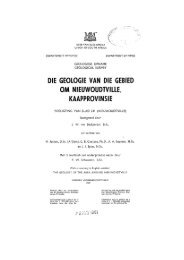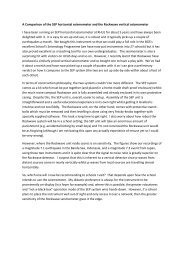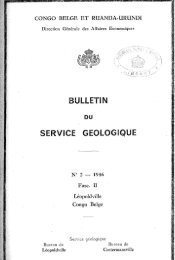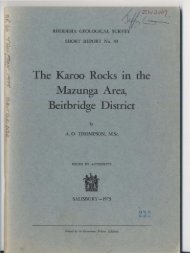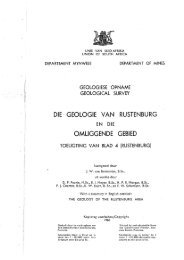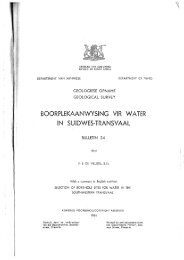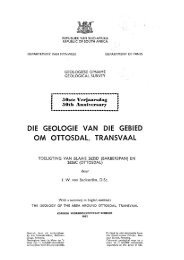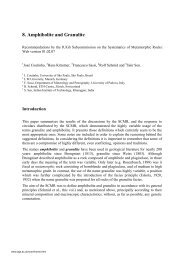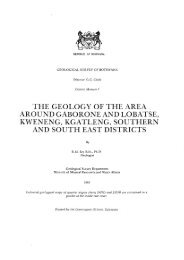Bibliography - British Geological Survey
Bibliography - British Geological Survey
Bibliography - British Geological Survey
Create successful ePaper yourself
Turn your PDF publications into a flip-book with our unique Google optimized e-Paper software.
K. A. R. Kennedy, pp. 268–269; M. K. Nickels, pp. 269–270; N. Roland, pp. 270–271; C. Runnels, pp. 271–<br />
272; F. Spencer, pp. 272–273; C. B. Stringer, p. 273; N. C. Tappen, pp. 273–274; B. G. Trigger, pp 274–<br />
275; S. Washburn, pp. 275–276; R. V. S. Wright, pp. 276–277.)<br />
Tobias, P. V. 1992d. The case against Keith re-visited: reply to two critics. Adler Museum Bulletin, 18 (2),<br />
26‒28.<br />
Tobias, P. V. 1993. On Piltdown: the French connection revisited. Current Anthropology, 34, 65–67.<br />
Tobias, P. V. 1999a. Frank Spencer: quiet anthropologist whose detective work cracked the hoax of Piltdown<br />
man. Guardian, 6 July, 20. (Obit: born 1 May 1941, died 30 May 1999. ‘The fame of the scholarly, bookish<br />
Frank Spencer, who has died of cancer aged 58, rests on the case he made that Sir Arthur Keith was the likely<br />
co-conspirator, with Charles Dawson, in one of the most notorious frauds in the history of science, the infamous<br />
Piltdown hoax.’ So says Phillip V. Tobias, who confines his obituary to an examination of this single theme<br />
in Spencer’s life, reflecting as it does Tobias’s own anti-Keith agenda.)<br />
Tobias, P. V. 1999b. In memoriam: [Frank Spencer]. American Journal of Physical Anthropology, 110,<br />
393–398.<br />
Tobias, P. V. & Kennedy, K. A. R. 1993. On Arthur Keith’s cover: in other words. Current Anthropology,<br />
34, 67–68.<br />
Tobias, P. V. (see Turrittin 2006 for other Piltdown-related communications from this author)<br />
Toldt, C. 1915. Über den vorderen Abschnitt des menschlichen Unterkiefers mit Rücksicht auf dessen<br />
anthropologische Bedeutung. Mitteilungen der Anthropologischen Gesellschaft in Wien, 45, 236–267.<br />
(Remarks on Piltdown Man, pp. 248–249, 266. The author considers the skull and jaw to be incompatible.<br />
The anterior part of the Piltdown mandible is too apelike in character, compared with either Heidelberg or<br />
Neanderthal, whereas the cranium is essentially human. Toldt commented on Piltdown in two earlier papers<br />
in 1914, which are cited in Quenstedt 1936, 153, 192.)<br />
Toombs, H. A. 1952. A new section in the Piltdown gravel. South-Eastern Naturalist and Antiquary, 57,<br />
31–33. (A ‘witness section’ in the Piltdown gravel has been preserved by the Nature Conservancy as a<br />
permanent <strong>Geological</strong> Monument. The new section, which cuts through the old hedge about 2 m from the<br />
stone monolith monument, was dug in Sept 1950. The NW end of the witness section encountered an old<br />
rubbish-filled trial trench on the opposite side of the hedge [probably dug by Smith Woodward in the years<br />
after Dawson’s death]. This old trial features in a <strong>Geological</strong> <strong>Survey</strong> photograph dating from 1925, A.2942.<br />
Although all the material dug from the new trench was sieved and carefully examined by K. P. Oakley, A. E.<br />
Rixon and the writer (all of the Natural History Museum), no bones, teeth, or implements were found. The<br />
presence of reddened flints and occasional quartz and quartzite pebbles in the gravel was confirmed. None of<br />
the reddened flints appeared fire-crackled. The section was then bricked-in, save for a couple of small glass<br />
doors, 2ft 3ins by 1ft 3ins, on either side of the trench at its NW end.)<br />
Townshend, G. L. 1981. Piltdown puzzle. New Scientist, 91 (24 Sept), 823. (In response to the series of<br />
papers by Harrison Matthews (1981), the writer questions how the Piltdown cranial fragments were<br />
radiocarbon dated, given the reported absence of collagen.)<br />
Trevor, J. C. (see under Costello 1986. Jack Trevor, a physical anthropologist at University of Cambridge,<br />
wrote to Oakley on 13 Feb 1967 accusing Woodward of being co-conspirator with Dawson, and sent also a<br />
rough draft of a communication he evidently planned to publish in Nature; see Spencer 1990a, 232 note 78,<br />
& Spencer 1990b, 214–15.)<br />
Trigger, B. G. 1992 (contribution to discussion in Tobias 1992c)<br />
Turner, E. E. 1955. John Theodore Hewitt, 1868–1954. Biographical Memoirs of Fellows of the Royal<br />
Society, 1, 79–99, plate. (Hewitt was a prominent chemist, ‘a gay, kindly figure’, who in 1986 became one<br />
of the Piltdown-accused in consequence of something he had said, presumably in jest, a year or so before he<br />
died. See Daniel 1986, Costello 1986.)<br />
Turrittin, T. H. 2004. Alvan T. Marston: a historical character study. Published on the Web.<br />
http://members.shaw.ca/tom.t/pilt/marston.html (Focuses on Marston’s relationship to Piltdown and<br />
attempts to explain his refusal to accept that the Piltdown assemblage was fraudulent or that Dawson, an<br />
amateur like himself, was involved in any wrong doing. Marston also wanted the experts to admit that they



